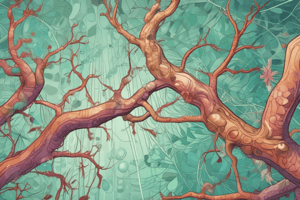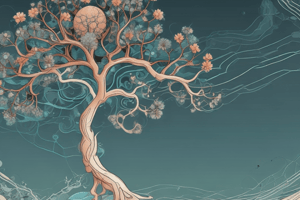Podcast
Questions and Answers
Which branch of biology studies the interactions between organisms and their environment?
Which branch of biology studies the interactions between organisms and their environment?
- Zoology
- Botany
- Ecology (correct)
- Microbiology
What is the function of the Golgi apparatus in a cell?
What is the function of the Golgi apparatus in a cell?
- Energy generation
- Protein modification and transport (correct)
- Protein synthesis
- DNA replication
What is the molecule that contains genetic information?
What is the molecule that contains genetic information?
- DNA (correct)
- RNA
- Carbohydrate
- Protein
What is the process by which individuals with favorable traits are more likely to survive and reproduce?
What is the process by which individuals with favorable traits are more likely to survive and reproduce?
What is the study of evolutionary relationships between organisms?
What is the study of evolutionary relationships between organisms?
What are the non-living components of an ecosystem?
What are the non-living components of an ecosystem?
What is the function of carbohydrates in living organisms?
What is the function of carbohydrates in living organisms?
What is the process by which cells generate energy from glucose?
What is the process by which cells generate energy from glucose?
Flashcards are hidden until you start studying
Study Notes
Branches of Biology
- Botany: study of plants
- Zoology: study of animals
- Microbiology: study of microorganisms
- Ecology: study of interactions between organisms and their environment
Cell Biology
- Cell: basic unit of life
- Cell membrane: thin layer of lipid and protein molecules that surrounds the cell
- Cell organelles:
- Nucleus: contains genetic material (DNA)
- Mitochondria: generates energy for the cell
- Ribosomes: site of protein synthesis
- Lysosomes: contains digestive enzymes
- Golgi apparatus: involved in protein modification and transport
Genetics
- DNA (Deoxyribonucleic acid): molecule that contains genetic information
- Genes: segments of DNA that code for specific traits
- Chromosomes: thread-like structures made up of DNA and proteins
- Inheritance: passing of traits from parents to offspring
- Genetic variation: differences in DNA sequence between individuals
Evolution
- Theory of evolution: explains how species change over time
- Natural selection: process by which individuals with favorable traits are more likely to survive and reproduce
- Speciation: formation of new species
- Fossil record: provides evidence of evolutionary history
- Phylogeny: study of evolutionary relationships between organisms
Ecosystems
- Ecosystem: community of living and non-living components interacting with each other
- Biotic factors: living components (organisms)
- Abiotic factors: non-living components (environmental factors)
- Energy flow: movement of energy from one level to the next in an ecosystem
- Nutrient cycling: recycling of nutrients through an ecosystem
Biological Molecules
- Carbohydrates: provide energy and structure
- Proteins: perform various functions in the cell (enzymes, hormones, etc.)
- Lipids: provide energy and structure
- Nucleic acids: contain genetic information (DNA and RNA)
Biological Processes
- Photosynthesis: process by which plants convert light energy into chemical energy
- Respiration: process by which cells generate energy from glucose
- Digestion: breakdown of nutrients into smaller molecules
- Osmosis: movement of water molecules from high to low concentration
Branches of Biology
- Botany is the study of plants and their characteristics.
- Zoology is the study of animals, including their structure, behavior, and evolution.
- Microbiology examines microorganisms, such as bacteria and viruses, and their interactions with the environment.
- Ecology focuses on the interactions between organisms and their environment, including population dynamics and ecosystem processes.
Cell Biology
- A cell is the basic unit of life, and all living organisms are composed of one or more cells.
- The cell membrane is a thin layer of lipid and protein molecules that surrounds the cell and regulates the movement of materials in and out.
- The nucleus contains genetic material (DNA) and is often referred to as the control center of the cell.
- Mitochondria are the site of cellular respiration, generating energy for the cell through the process of ATP production.
- Ribosomes are responsible for protein synthesis, and lysosomes contain digestive enzymes that break down and recycle cellular waste and foreign substances.
- The Golgi apparatus is involved in protein modification and transport, packaging proteins and lipids for transport out of the cell.
Genetics
- DNA (Deoxyribonucleic acid) is a molecule that contains the genetic information necessary for the development and function of an organism.
- Genes are segments of DNA that code for specific traits or characteristics, and they are expressed through the process of gene expression.
- Chromosomes are thread-like structures made up of DNA and proteins that carry genetic information in the nucleus of eukaryotic cells.
- Inheritance refers to the passing of traits from parents to offspring through the transmission of genetic information.
- Genetic variation occurs when there are differences in the DNA sequence between individuals, leading to differences in traits and characteristics.
Evolution
- The theory of evolution explains how species change over time through the process of natural selection, genetic drift, mutation, and gene flow.
- Natural selection is the process by which individuals with favorable traits are more likely to survive and reproduce, passing those traits on to their offspring.
- Speciation occurs when a new species emerges from an existing one, often as a result of geographic isolation or other mechanisms.
- The fossil record provides evidence of evolutionary history, with fossils of ancient organisms providing clues about the evolutionary relationships between organisms.
- Phylogeny is the study of evolutionary relationships between organisms, constructing family trees to show how different species are related.
Ecosystems
- An ecosystem is a community of living and non-living components interacting with each other in a specific environment.
- Biotic factors include all living components of an ecosystem, such as plants, animals, fungi, and microorganisms.
- Abiotic factors are non-living components of an ecosystem, including light, temperature, water, soil, and nutrients.
- Energy flow occurs in an ecosystem when energy is passed from one level to the next, from producers to consumers, and eventually to decomposers.
- Nutrient cycling involves the recycling of nutrients through an ecosystem, with decomposers breaking down organic matter and releasing nutrients back into the environment.
Biological Molecules
- Carbohydrates are biological molecules that provide energy and structure for organisms, including sugars, starches, and cellulose.
- Proteins perform various functions in the cell, including acting as enzymes, hormones, and structural components.
- Lipids are biological molecules that provide energy and structure for organisms, including fats, oils, and waxes.
- Nucleic acids, such as DNA and RNA, contain genetic information and are essential for the transmission of genetic traits.
Biological Processes
- Photosynthesis is the process by which plants, algae, and some bacteria convert light energy from the sun into chemical energy in the form of glucose.
- Respiration is the process by which cells generate energy from glucose, releasing carbon dioxide and water as byproducts.
- Digestion involves the breakdown of nutrients into smaller molecules that can be absorbed and utilized by the body.
- Osmosis is the movement of water molecules from an area of high concentration to an area of low concentration through a selectively permeable membrane.
Studying That Suits You
Use AI to generate personalized quizzes and flashcards to suit your learning preferences.




